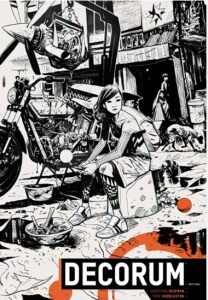Kieran Alexander – writer
Christopher Wood – artist
Independently published, 2023

When we write a review for this website, we think about the best way of cataloguing it by genre. This for people interested in those topics queued on the righthand side of this webpage (assuming you are reading this critique on a laptop). The process of taxonomy often stumps us. Such is the variety of the medium of comic books: it has led us to create many more categories of theme than we would ever have anticipated. We did not have a category for “surreal”. With this title, now we do.

The Coffee Table starts off with a delight of absurdity. A bland coffee table in a share house decides that it will pay $100 for each cup of coffee placed upon it. The cup must be white. It must contain coffee. The cup will then disappear. In the cup’s place is a crisp one hundred dollar note. There is no explanation as to why this occurs. The beginning of the story reminds us of the motion picture Being John Malkovich. Sometimes, impossible things happen, and people will react to that impossibility in predictable ways.
Wallace and Hannah are our protagonists. Wallace is quite happy just to take the cash and spend it. Wallace himself acts in a ridiculous way. asserting that making coffee and getting $100 notes for each is tiring work. Soon the apartment fills up with ridiculous purchases – video games, two quad bikes, expensive watches, even a suit of armour. This is worse than a nouveau riche response to newfound wealth: Wallace has no idea how to deal with money at all and scatters it on the carpet. Wallace is not especially likeable.
Hannah is smarter than Wallace. She has a back story – the framed and faded memory of a child and a partner, with no insight to the reader into what has happened other than sadness, and the new toys do not mitigate quiet grief. The first cup to be absorbed by the coffee table featured a child’s drawing, and from Hannah’s reaction to its loss we know it was treasured.
Artist Christopher Wood does a wonderful job of conveying the emotions of the two through slick facial expressions: the furrowed brow and the insomniac’s smouldering anger of Hannah, and the consumerist’s smugness of Wallace.
Writer Kieran Alexander then takes us off into the bushes. In the early hours, Hannah glances at the coffee table. There on a small piece of paper is the word, “Hello”.
With that ending to the first chapter, the plot careens off onto an intriguing tangent. The coffee table is not just a weird ATM. It is sentient and wants to communicate.
Exchanging coffee for money is a strange deal to do with a devil. Wallace is happy to engage in wilful blindness. (“What more is there to understand? It takes coffee and it gives money. That’s it. That’s the whole story.”) But, as Hannah observes to a petulant Wallace, there might be a price to pay. “This isn’t a discussion, Wallace. No more coffee. Otherwise, we’re going to take it too far and who knows what might happen,” says Hannah.

But while the story starts off as a surreal exercise, in the end of the second chapter it turns into an alternative reality or time travel story. The only disappointing aspect to The Coffee Table, with its excellent dialogue and pleasing art (for some reason we are reminded the work of Tony Harris), is that there is an explanation.
We have been promised a third and fourth chapter, and very much look forward to it. You can find Mr Alexander on Instagram https://www.instagram.com/kieranalexandercomics/ and Mr Wood on his website: Comics — Chris Wood

